From an article I recently wrote about the use of Batteries in Eve Thermo and tado thermostats wrote, I became aware of lithium batteries, which are also available in sizes AA. After I had discovered them for the first time, my interest was of course piqued and I ordered the two products that I think would be most suitable: EBL and Blackube.
In this post, however, I first took a look at the EBL batteries to see how they fare in the test. The Blackube batteries have a slightly different design, a little less capacity, but charge almost twice as fast. But more on that in another post. First of all, here is the information about the EBL batteries.

Chapter in this post:
- 1 update: an EBL battery makes the LED flashlight flicker
- 2 Technical data of the EBL lithium batteries
- 3 Why lithium batteries and not NiMH?
- 4 Apple Magic Mouse 1 - a practical example
- 5 Warning notices regarding lithium batteries
- 6 Charging the EBL lithium batteries via the built-in micro USB socket
- 7 Advantage of the EBL batteries: charging and protection electronics directly integrated
- 8 LED signaling of the charging process
- 9 Problem with lithium batteries: no warning in case of "reserve"
- 10 Capacitance measurement difficult to implement
- 11 Comparison of EBL and Eneloop - calculate mAh and mWh
- 12 Price comparison turns out to be to the disadvantage of EBL batteries
- 13 charging cycles in comparison
- 14 My conclusion on the EBL lithium batteries
- 15 Similar posts
Update: an EBL battery makes the LED flashlight flicker
Overall, I think the EBL batteries are good, but you have to be aware that they have built-in electronics that may be defective. When testing one of the batteries, I noticed that my little LED UV flashlight does not light up continuously, but that there is always a flicker of maybe 20 to 30 Hz. You can see it with the eye. All other three EBL batteries, on the other hand, had produced a continuous light. So I'm relatively sure that something is wrong with one of the batteries. I am therefore sending my EBL set back.
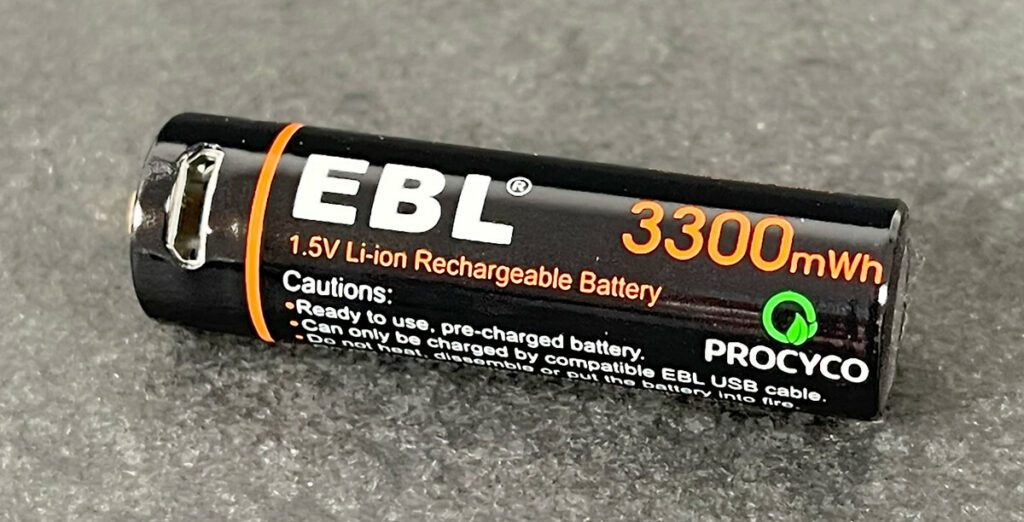
Technical data of the EBL lithium batteries
Before we go into detail, we should briefly list the specs of the batteries:
- Set of 4 EBL batteries
- Battery type: lithium
- Size: AA / Mignon / R6
- Voltage: V 1,5
- Capacity: 3300 mWh (corresponds to approx. 1,5 mAh at 2200 volts)
- Charge cycles: up to 1200
- Self-discharge: after 3 years still approx. 80%
- Charging time: about 2 hours
- Connection: Micro-USB
- Protective electronics in the battery: Overcharging, overdischarging (protection against deep discharge), overvoltage, overcurrent and short circuit
- Weight: approx. 17 grams per battery
- Power requirement when charging 4 batteries: 5 V / approx. 1,4 A (7 watts)
- Scope of delivery: 4x AA batteries, 1 battery box, 4-in-1 charging cable
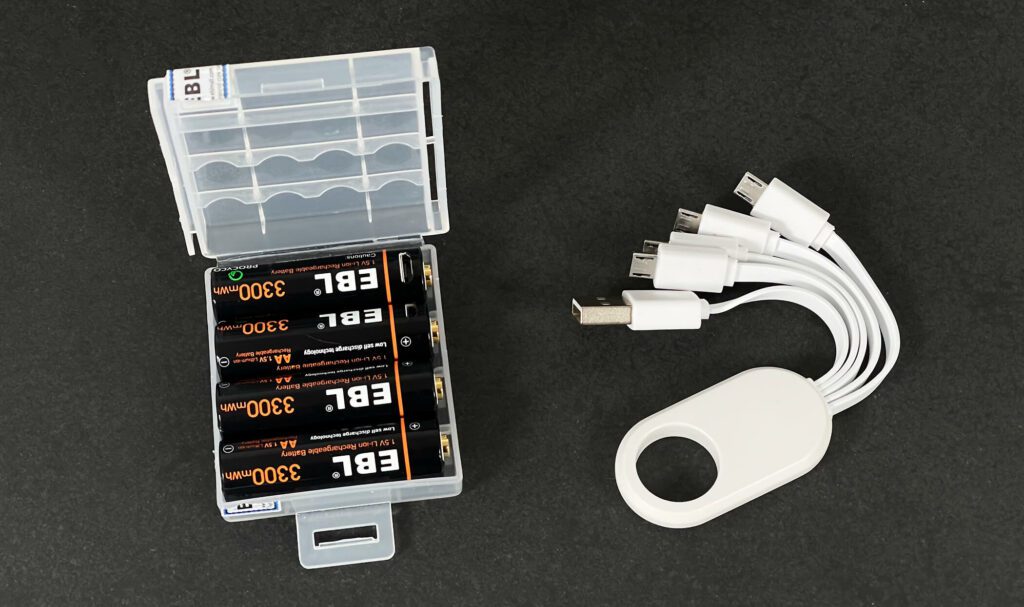
Why lithium batteries and not NiMH?
The big advantage that lithium batteries have over conventional nickel-metal hydride batteries is the higher voltage they supply. While the nominal voltage of the NiMH batteries is 1,2 volts, the lithium batteries offer 1,5 volts - just as much as a standard disposable alkaline mignon cell (also AA cell or IEC size R6).
Many devices that expect to be operated with single-use batteries throw a “battery almost empty” message when they have a NiMH battery inserted - even if the battery has been freshly charged.
This is because the devices expect 1,5 volts. Since the batteries only deliver 1,2 volts, they assume that they are dealing with an almost completely discharged battery.
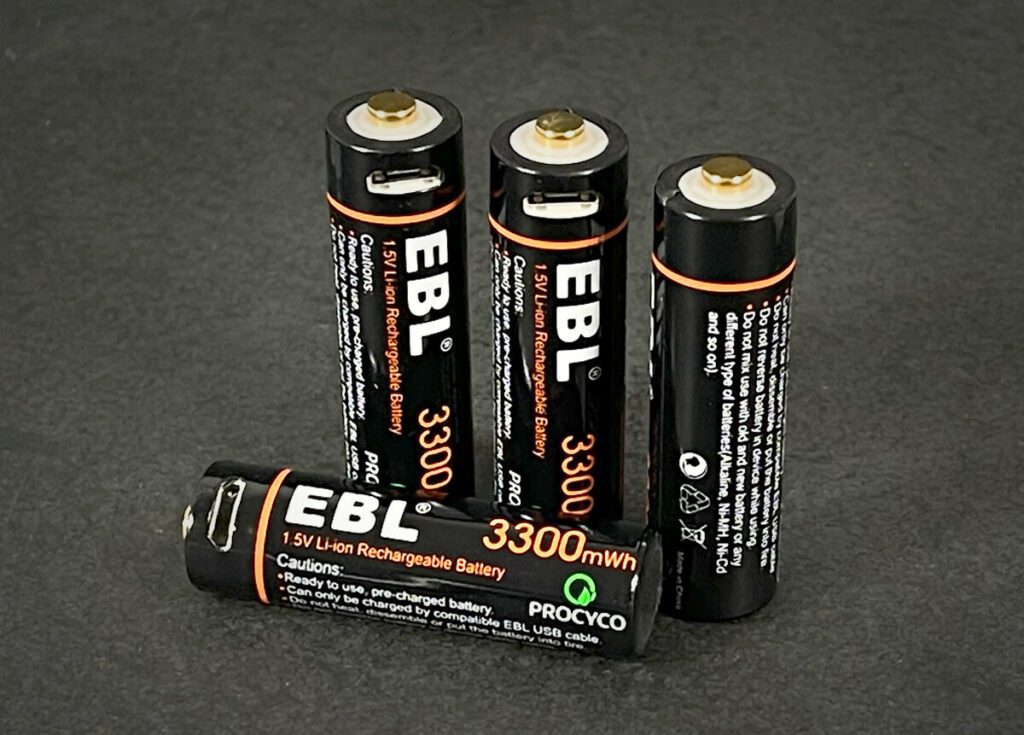
Apple Magic Mouse 1 - a practical example
I've been using my old Magic Mouse from Apple - the model without a Lightning socket - with batteries for years and it happens again and again that the Apple mouse has recurring disconnections even though it has been given fresh batteries. In my opinion, this is also due to the fact that it requires a higher voltage than 1,2 volts and works with batteries at the lower limit.
Yesterday - after trying four different NiMH batteries (including Eneloops!) - I was finally able to achieve success with the lithium batteries. The mouse ran immediately after inserting the batteries until today without a single further breakdown.
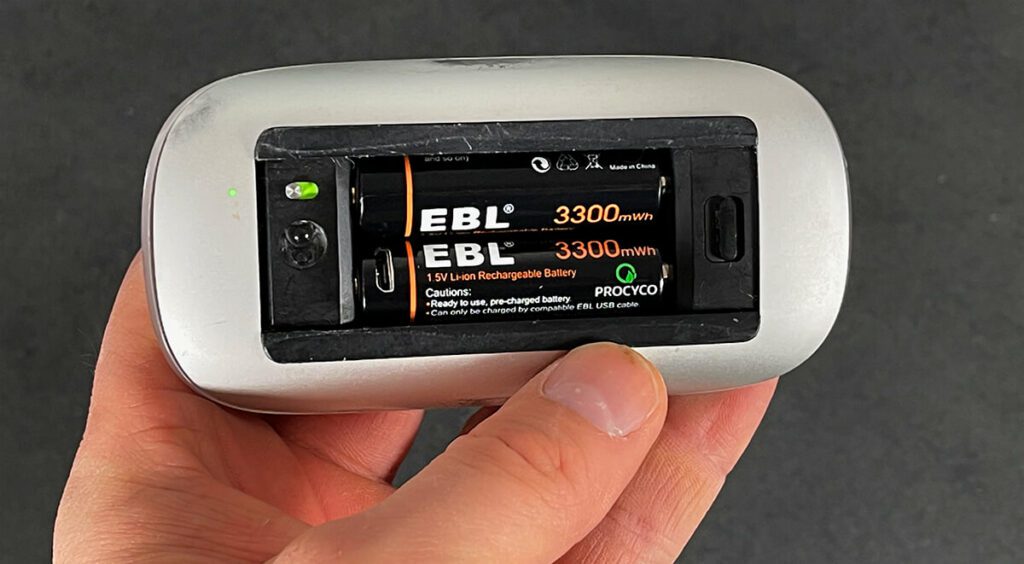
Lithium battery warnings
Before there is a song of praise for lithium batteries, I would like to note that this type of battery also harbors its dangers, because lithium is a "highly dangerous" substance. With such batteries, a slight damage to the jacket is often enough to set them on fire, because the lithium reacts strongly exothermically with water and air.
A chemical reaction is exothermic when it releases more energy than was initially supplied as activation energy. (Wikipedia)
You should therefore be very careful with these batteries, do not carry them in your pocket and, if possible, do not drop them or damage them in any way. We had in the forum a longer thread on this.
I would even recommend putting them in a so-called when they are not in use Lipo bag to pack if you store them for a long time. This is also what all model pilots who deal with such batteries (mostly with larger capacities) do the same.
If you want to get an impression of how lithium batteries react when damaged, you can go to YouTube and search "Lithium battery explodes" to inform.
In any case, you don't have these problems with NiMH batteries. If you hit them with a hammer, they'll break, but there's no explosion or fire.
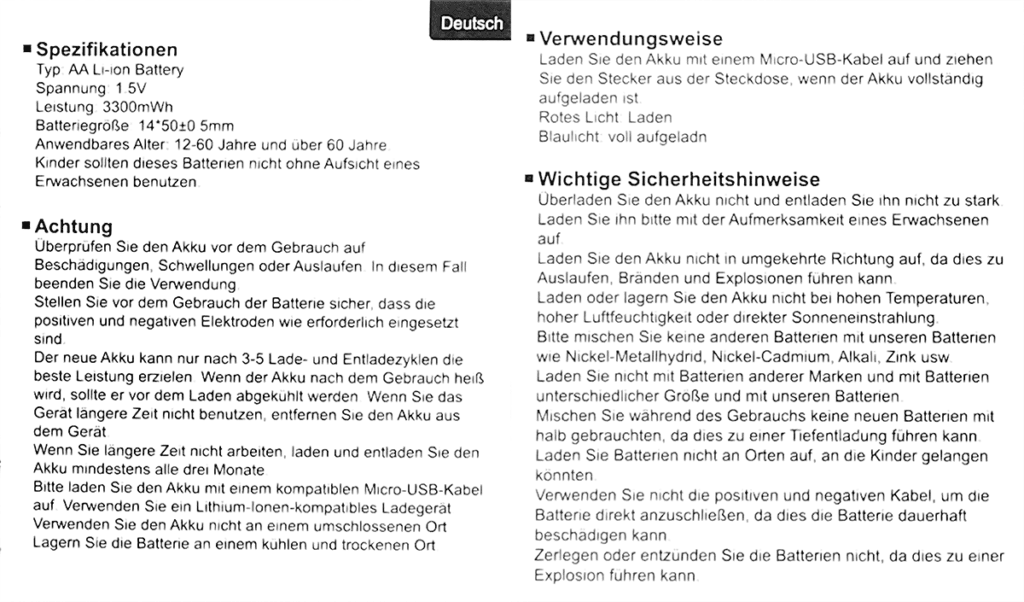
Charging of the EBL lithium batteries via the built-in micro USB socket
From my point of view, the innovative thing about the lithium batteries from EBL is that you can use a Micro-USB Socket can charge, which is built into the battery. This brings us to my point of criticism: Micro-USB has been driving me crazy for years. I keep fumbling around with the micro USB plugs on the charging sockets of various devices, only to find that I'm holding the plug the wrong way round again.
In addition, the micro-USB connector is always a bit clunky and the socket of the EBL batteries is no exception. I would have liked to see a USB-C alternative to the micro-USB rechargeable batteries, but I haven't found anything on the capital A yet. There are of Hitrends lithium batteries with USB-C charging socket, but these are only available in sizes C and D.
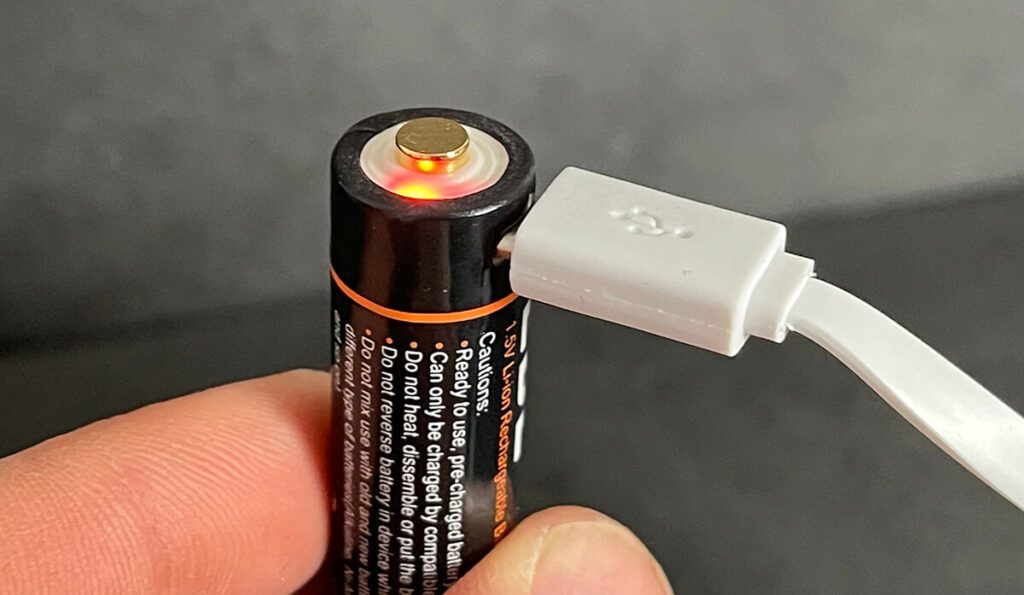
However, charging the EBL batteries works without any problems on any USB power supply unit that has a USB-A output and can deliver at least 7,5 watts. The supplied charging cable, which offers four micro-USB plugs that fit into the batteries, is plugged into the USB-A port.
In principle, it would even work with the old 5-watt mini plug-in power supply from Apple, which used to come with every iPhone. But then you have to plan a little more time for charging.
- Read more: Sanyo eneloop battery AA / AAA - test and charger recommendation from me
- Read more: AA rechargeable batteries, batteries or battery module for the Lego Mindstorms EV3 Brick?
- Read more: Sanyo charger and an alternative to the Eneloop charging stations
Advantage of the EBL batteries: charging and protection electronics directly integrated
In addition to the micro-USB socket, charging electronics and protective electronics are also built in. This prevents the battery from being overcharged or deeply discharged or from being damaged by a short circuit. This is also extremely important with lithium batteries, as otherwise there would be an acute risk of fire.
The deep discharge protection also avoids the problem that one has with NiZn batteries: The electronics in the devices in which the batteries are used do not recognize that they are already marginally empty and continue to draw energy from the batteries. As a result, they are deeply discharged and often permanently damaged. The result is that they lose a large part of their original capacity and can actually no longer be used properly.

Signaling of the charging process via LED
At the plus pole of the batteries, there is an LED next to the pole cap, which lights up red when the charging process is in progress. When charging is finished, the LED lights up blue.
The LED does not light up during operation and there are no displays to indicate whether the battery is almost empty. In most cases, this would be superfluous, as the batteries are typically inserted into devices and nothing can be seen from the outside.
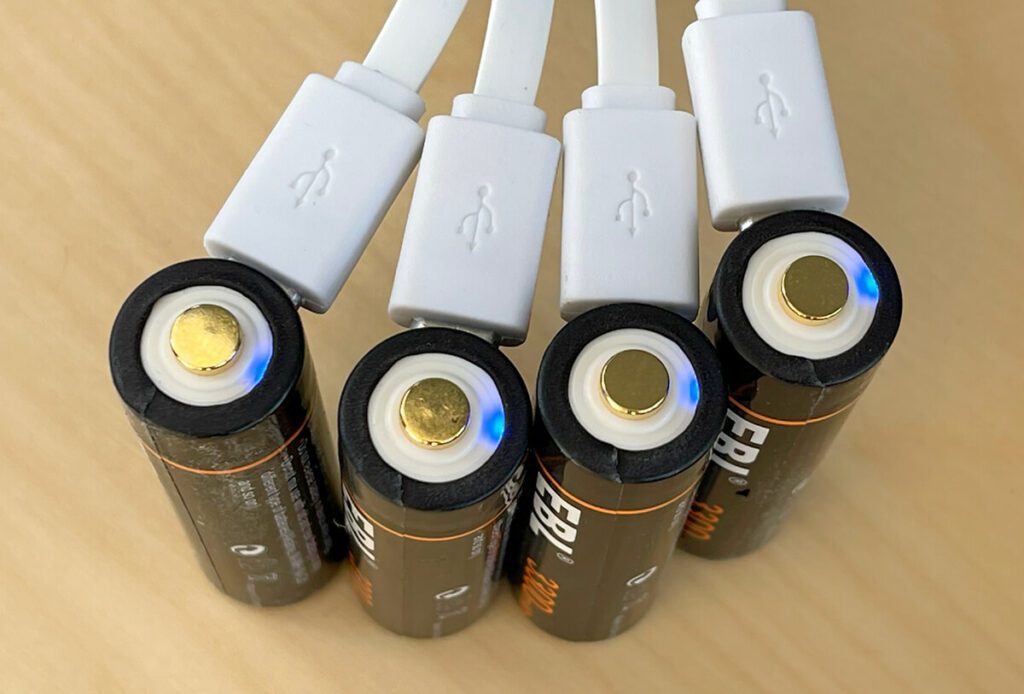
Problem with lithium batteries: no advance warning for "reserve"
A small problem that you have with lithium and NiZn batteries is the problem with the non-feasible “battery almost empty” warning. With lithium batteries, there is no gradually decreasing voltage curve from which you could tell that the battery is almost empty.
Instead, it delivers 1,5 volts almost continuously and at some point, when the discharge electronics find that it is empty enough, they simply cut the connection. This is not so tragic with a remote control or a remote-controlled car, but if I operate my carbon monoxide alarm with two AA cells and it just stops working at some point without sending me a warning tone, then this is dangerous.
For this reason, I would recommend that you consider beforehand which devices you would like to insert the lithium batteries into. If something bad happens, if they suddenly just switch off, then I would prefer to use disposable batteries.
Another way: If you still want to use the lithium batteries, I would create a reminder in the iPhone that reminds you to change the batteries in the corresponding device after a certain time. If the period is short enough, you may never get into the situation where the batteries no longer supply power.
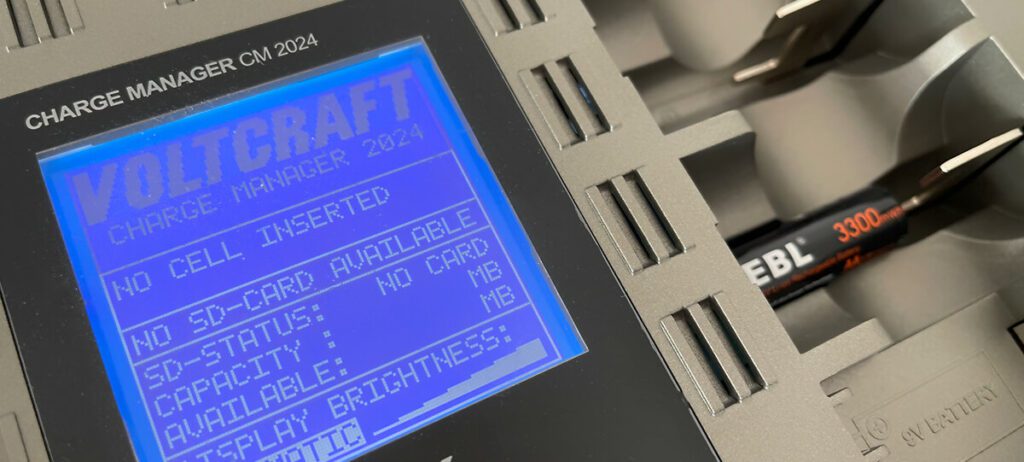
Capacitance measurement difficult to implement
I thought for a moment that I could have the batteries pre-charged in mine Voltcraft Charge Manager CM2024 throw it and then discharge it in a controlled manner to find out how much capacity I can actually take. Unfortunately, this did not work because the charger did not recognize any of the batteries.
On the one hand, this is a shame, because I would have liked to have checked the capacity, but on the other hand, it is also reassuring, because that way I know that it doesn't matter if my wife accidentally puts such a battery in the charger. The batteries should only be charged via a micro USB socket and not, like normal batteries, in a charger.
Compare EBL and Eneloop - calculate mAh and mWh
Since I still wanted to know how the batteries compare to the proven Eneloop batteries in terms of capacity, I checked briefly what capacity both types of batteries have:
- Eneloop: 2000 mAh (corresponds to about 1,2 mWh at 2400 V)
- Eneloop Pro: 2500 mAh (corresponds to about 1,2 mWh at 2880 V)
- EBL: 3300 mWh (corresponds to about 1,5 mAh at 2200 V)
In this case, the specification of watt hours is much more suitable for comparison, as the battery types have different voltages.
At this point a reference to my article about the abbreviation “mAh” and the explanation why Wh is the better unit for comparisons.
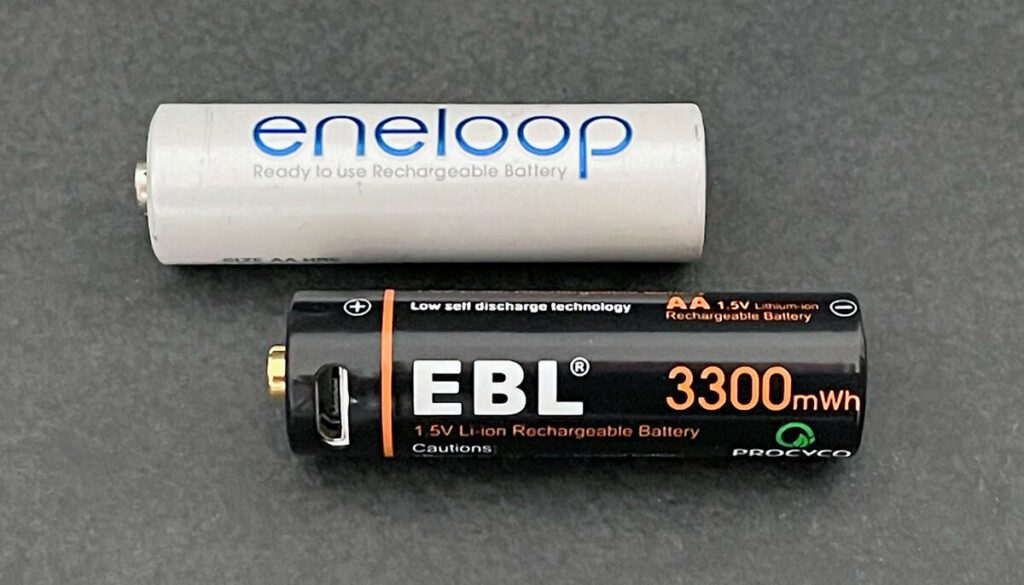
If you convert the information into milliwatt hours (mWh), the following values result:
- EBL batteries: 3300 mWh
- Eneloop Pro batteries: 2880 mWh
- Eneloop batteries: 2400 mWh
Price comparison turns out to be to the disadvantage of EBL batteries
But if you look at the price, the EBL batteries have to be in the back of the line, because the Eneloop batteries are significantly cheaper.
- Eneloop battery (each) approx. 3,50 euros
- Eneloop Pro battery (each): approx. 4,43 euros
- EBL battery (each): approx. 6,15 euros
Comparison of charging cycles
When comparing batteries, it is of course also interesting how many charging cycles the batteries can hold out. I don't have any empirical values here that I could give in numbers, but the manufacturer's information is in principle enough to provide a basis for comparison:
- Eneloop battery: 2100 cycles
- Eneloop Pro battery: 500 cycles
- EBL lithium battery: 1200 cycles
You can see that the Eneloop Pro are strong in terms of capacity, but they bring up the rear when it comes to the number of charging cycles. The EBL batteries are even better than the Eneloop Pro in terms of capacity and are in the midfield with 1200 charging cycles.
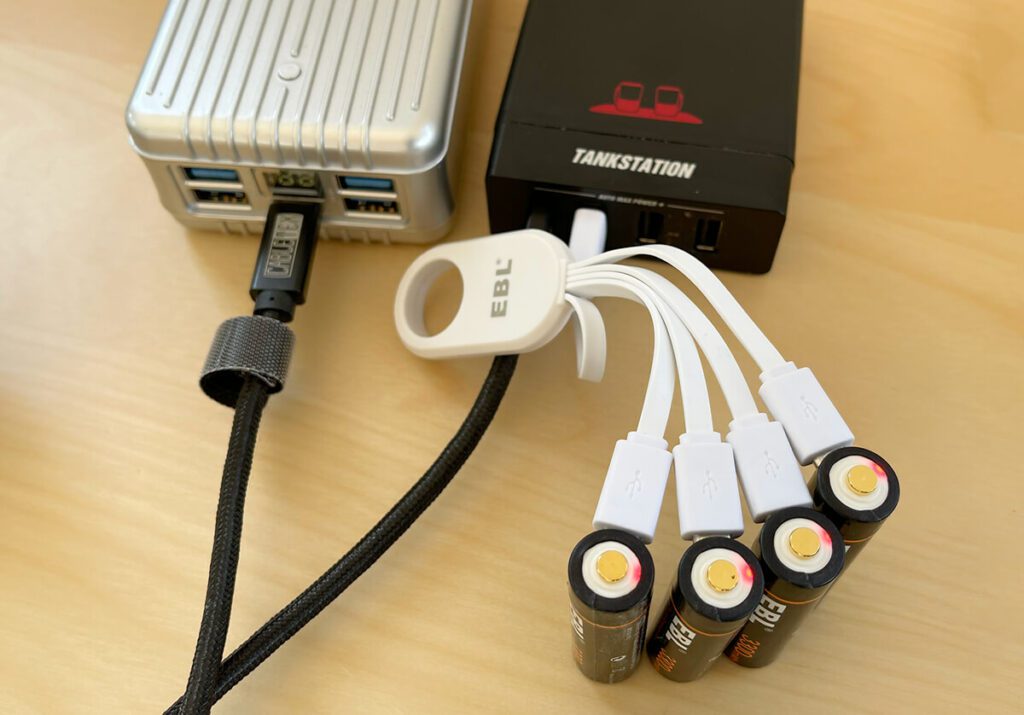
In the photo above, I charge the batteries on one tizi filling stationwhich one also mine Zendura A8 is loaded. Both very recommendable devices, which I have not regretted buying.
My conclusion on the EBL lithium batteries
The price of approx. 25 euros for 4 EBL AA batteries hurts a bit when you Amazon Basics prices or the cheap Eneloops is used to. Nevertheless, I find the EBL batteries very good because they have a very low self-discharge and a built-in protection against a possible deep discharge.
On the other hand, I only like charging via micro-USB with the EBL lithium batteries to a limited extent, but the high capacity and low self-discharge are points that I can use in my device environment.
In any case, the Apple mouse and my Eve Thermo are gradually being converted to this type of battery. You probably won't notice the higher price if you gradually increase your range.
If you are interested in the EBL lithium batteries in size AA (Mignon), you will find them here at Amazon.
Related Articles
Jens has been running the blog since 2012. He acts as Sir Apfelot for his readers and helps them with technical problems. In his spare time he rides electric unicycles, takes photos (preferably with the iPhone, of course), climbs around in the Hessian mountains or hikes with the family. His articles deal with Apple products, news from the world of drones or solutions to current bugs.


![[Update] Apple Watch battery capacity (mAh & Wh) of all models and editions](https://a391e752.rocketcdn.me/wp-content/uploads/2021/10/apple-watch-akku-mah-wh-150x150.jpg)
![[Update] Overview: Battery capacity (mAh & Wh) of the Apple iPad models](https://a391e752.rocketcdn.me/wp-content/uploads/2024/04/ipad-battery-capacity-mah-wh-150x150.jpg)






Thanks for the detailed test - I also got the taste and will now look around.
Do you know if something is also emerging in the AAA area? When I look around my apartment, the AA battery has been pushed out of many devices due to its larger size.
Hello Simon! The AAA lithium batteries are also available, but because of their size, they do not have a micro-USB connection. However, they also come with the integrated protection circuit that protects against deep discharge. I found these manufacturers with AAA LiIon batteries at the large A department store:
I hope this helps you further. LG, Jens
I was lucky enough to get 4 Blackube AAA with USB. Unfortunately the link to my order runs z. Currently in the void
Hi Peter! So AAA batteries with a micro USB socket? Or with a USB charger?
They are AAA lithium batteries with the USB connection on top next to the positive pole. A 4-way cable was included. But unfortunately it can no longer be found on amazon at the moment. My blood pressure monitor now pumps with 1,5V twice as fast as with 1,2V.
Great! Hopefully the heart doesn't pump twice as fast either. ;-)